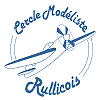 |
Cercle Modéliste Rullicois |
Updated 12/02/2025 |

The Aircraft
FREE FLIGHT F1 |
|---|
F1 A Glider: Free like the air, the models are it! The sailplanes are launched using a nylon cable, like a kite. At the desired time, the aero modeller releases the model which flies without physical or radio connection. |
F1 B Rubber Powered Plane: A plane with a rubber engine driven propeller, turned by rubber bands twisted on themselves. When the engine shuts down, the plane flies like a sailplane. |
F1 C Thermal Engine Plane: The glider is provided with a piston engine which provides power to gain altitude. When the engine shuts down, the plane flies like a sailplane. |
F1 D Microfilm Indoor Flight: The models are extra-light. Most astonishing are the microfilms with 65 cm of wingspan and a weight of 1 gram! ! ! The categories are microfilm, EZB, peanut, Sainte formula. |
F1 E Slope Soaring Glider: Slope flying with magnetic guidance. Launched on a slope, the sailplane keeps into the wind using an “autopilot” located in front of the fuselage and functioning with a magnet which maintains it in a North-South direction. A flap pivoted on a fixed shaft located in front of the fuselage, is connected to the magnet and regulation is combined in order to keep the sailplane in a fixed direction. |
CONTROL LINE F2 The model is connected to a pilot via two cables. It flies in a half-sphere with the pilot at the centre. |
|---|
F2 A SPEED: The test consists of reaching a maximum speed on one kilometre distance (that is to say nine turns with a radius of 17,69 m) with an engine of cubic capacity imposed of 2,5 Cm3. The world records are more than 360 km/hr. |
F2 B ACROBATICS: Piloting of precise manoeuvres, acrobatics consists of carrying out a program of compulsory figures in an exact order and in a given time |
F2 C TEAM RACING: Aeroplane racing with obligatory re-fuelling. The formula `Mans' of the circular flight… it is a test that puts three teams in competition in the same circle, each team being made up of a pilot and a mechanic. The first aeroplane to cover 10 km (100 turns). The engine is started by the mechanic and then launched. The tank is limited to 7cm3 which means that the pilot will have to land twice to be re-fuelled by its mechanic. Speed: more than 200 km/hr. |
F2 D COMBAT: Cut before the cut… The combat puts two models in the same circle. The two pilots, helped each by two mechanics must by controlling their planes, cut the streamer fixed on the back of the other plane. Each cut carried out on the streamer by the adversary gains points. |
RADIO CONTROLLED FLIGHT F3 The on-board radio control equipment, receiving signals from the competitor's transmitter, actuates the control surfaces to enable aerobatic performance to allow him to perform a program of compulsory figures (F3 A Stunt-flying and F3 C Helicopter) or to seek ascents (F3 B Glider). The aeroplanes can be powered by combustion engine or electric motor. For beginners a plane of modest performance that is easy to fly is recommended. Ideally the beginner should join a club for advice before purchasing the equipment. |
|---|
F3 A STUNT-FLYING: Involves complex aerial manoeuvres with a radio controlled model aircraft, where utmost precision and skill in controlling the model aircraft in any attitude and under all conditions is required. The motive power is usually an internal combustion engine, with no power limitations, but the engine has to be adequately silenced. |
F3 B GLIDER: Several categories of sailplane i.e. speed, duration, towing, stunt-flying. Slope flying or Level plain. |
F3 C HELICOPTER: Hovering, loop, barrel, autorotation to make compulsory figures. |
F3 D PYLON RACING: A race around three pylons. |
F3 K GLIDER HAND LAUNCH: The F3K is a radio controlled sailplane, wingspan1m50, attaining altitude by holding a wing tip and throwing the plane into the air by means of a fast rotation of the body. The continuation of the flight is done while seeking and exploiting the thermal currents, in fact one of the most respectful disciplines of environment This so named technique " SAL" (side arm launch) or " DLG" (discus launch glider) is recent and is fully adopted. There are l other categories of sailplane i.e. speed, duration, towing, stunt-flying. Slope flying or Level plain. etc............. |